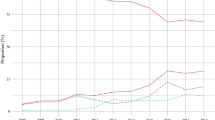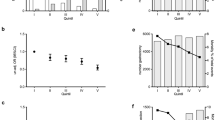Abstract
Background
Outcomes after nonelective surgery for gastric cancer (GC) are poorly defined. Our objective was to compare outcomes of patients undergoing nonelective GC surgery after admission through the emergency department (EDSx) with patients receiving elective surgery or surgery after planned admission (non-EDSx) nationally.
Methods
The Nationwide Inpatient Sample (NIS) database was used to examine patients undergoing GC surgery between 2008 and 2012. Demographics and outcomes were compared between EDSx and non-EDSx. Multivariable logistic regression was used to examine predictors of discharge to home.
Results
Of 9279 patients, 1143 (12%) underwent EDSx. They were more likely to be female (42 vs. 35%), nonwhite (56 vs. 33%), aged ≥75 years (40 vs. 26%), in the lowest quartile for household income (31 vs. 25%), have one or more comorbidities (87 vs. 70%), treated at a nonteaching hospital (46 vs. 25%), and have a concomitant diagnosis of obstruction, perforation, or bleeding (30 vs. 6%). They had longer total length of stay (LOS; 16 vs. 9 days), longer median postoperative stays (10 vs. 9 days), higher in-hospital mortality (8 vs. 3%), and were less likely to be discharged home (63 vs. 82%). EDSx was more expensive ($125,300 vs. $83,604). EDSx was associated with a lower likelihood of discharge to home (odds ratio 0.52, 95% CI 0.43–0.62).
Conclusions
Nationally, 12% of GC surgeries are performed after emergency department admission, which occurs more frequently in vulnerable populations and results in worse outcomes. Understanding factors leading to increased EDSx and developing strategies to decrease EDSx may improve GC surgery outcomes.

Similar content being viewed by others
References
Siegel R, Miller K, Jemal A. Cancer statistics, 2015. CA Cancer J Clin. 2015;65:5–29.
Havens JM, Peetz AB, Do WS, et al. The excess morbidity and mortality of emergency general surgery. J Trauma Acute Care Surg. 2015;78:306–11.
Haider A, Obirieze A, Velopulos C, et al. Incremental cost of emergency versus elective surgery. Ann Surg. 2015;262:260–6.
Oliphant R, Mansouri D, Nicholson GA, McMillan DC, Horgan PG, Morrison DS. Emergency presentation of node-negative colorectal cancer treated with curative surgery is associated with poorer short and longer-term survival. Int J Colorectal Dis. 2014;29:591–8.
Mallol M, Sabate A, Dalmau A, Koo M. Risk factors and mortality after elective and emergent laparatomies for oncological procedures in 899 patients in the intensive care unit: a retrospective observational cohort study. Patient Saf Surg. 2013;7:29.
Tataru D, Jack RH, Lind MJ, Moller H, Luchtenborg M. The effect of emergency presentation on surgery and survival in lung cancer patients in England, 2006–2008. Cancer Epidemiol. 2015;39:612–6.
Porta M, Fernandez E, Belloc J, Malats N, Gallen M, Alonso J. Emergency admission for cancer: a matter of survival? Br J Cancer. 1998;77:477–84.
McPhail S, Elliss-Brookes L, Shelton J, et al. Emergency presentation of cancer and short-term mortality. Br J Cancer. 2013;109:2027–34.
Kim J, Mittal R, Konyalian V, King J, Stamos MJ, Kumar RR. Outcome analysis of patients undergoing colorectal resection for emergent and elective indications. Am Surg. 2007;73:991–3.
Amri R, Bordelanou LG, Sylla P, Berger DL. Colon cancer surgery following emergency presentation: effects on admission and stage-adjusted outcomes. Am J Surg. 2015;209:246–53.
Elliss-Brookes L, McPhail S, Ives A, et al. Routes to diagnosis for cancer—determining the patient journey using multiple routine data sets. Br J Cancer. 2012;107:1220–6.
Vasas P, Wiggins T, Chaudry A, Bryant C, Hughes FS. Emergency presentation of the gastric cancer; prognosis and implications for service planning. World J Emerg Surg. 2012;7:31
Institute of Medicine. The unequal burden of cancer: an assessment of NIH research and programs for ethnic minorities and the medically underserved. Washington, DC: National Academies Press; 1999.
Livingwood WC, Smotherman C, Lukens-Bull K, et al. An elephant in the emergency department: symptom of disparities in cancer care. Popul Health Manag. 2016;19:95–101.
Healthcare Cost and Utilization Project. Overview of the Nationwide Inpatient Sample (NIS). https://www.hcup-us.ahrq.gov/nisoverview.jsp.
Cauley CE, Panizales MT, Reznor G, et al. Outcomes after emergency abdominal surgery in patients with advanced cancer: opportunities to reduce complications and improve palliative care. J Trauma Acute Care Surg. 2015;79:399–406.
Robinson T, Wallace J, Wu D, et al. Accumulated frailty characteristics predict postoperative discharge institutionalization in the geriatric patient. J Am Coll Surg. 2011;213:37–42.
Berian JR, Mohanty S, Ko CY, Rosenthal RA, Robinson TN. Association of loss of independence with readmission and death after discharge in older patients after surgical procedures. JAMA Surg. 2016;151:e161689.
Tsang C, Bottle A, Majeed A, Aylin P. Cancer diagnosed by emergency admission in England: an observational study using the general practice research database. BMC Health Serv Res. 2013;13:308.
Raine R, Wong W, Scholes S, Ashton C, Obichere A, Ambler G. Social variations in access to hospital care for patients with colorectal, breast, and lung cancer between 1999 and 2006: retrospective analysis of hospital episode statistics. BMJ. 2010;340:b5479.
Rabeneck L, Paszat LF, Li C. Risk factors for obstruction, perforation, or emergency admission at presentation in patients with colorectal cancer: a population-based study. Am J Gastroenterol. 2006;101:1098–103.
Beckett P, Tata LJ, Hubard RB. Risk factors and survival outcome for non-elective referral in non-small cell lung cancer patients—analysis based on the National Lung Cancer audit. Lung Cancer. 2014;83:396–400.
Pollock AM, Vickers N. Deprivation and emergency admissions for cancers of colorectum, lung, and breast in South East England: ecological study. BMJ. 1998;317:245–52.
Smith J, McPhee J, Hill J, et al. National outcomes after gastric resection for neoplasm. Arch Surg. 2007;142:387–93.
Holena D, Hadler R, Wirtalla C, Carr B, Morris J, Kelz R. Teaching status: the impact of emergency elective surgical care in the U.S. Ann Surg. 2011;253:1017–23.
Zafar S, Shah A, Hashmi Z, et al. Outcomes after emergency general surgery at teaching versus nonteaching hospitals. J Trauma Acute Care Surg. 2015;78:69–76.
Cunningham D, Allum WH, Stenning SP, et al. Perioperative chemotherapy versus surgery alone for resectable gastroesophageal cancer. N Engl J Med. 2006;355:11.
Ychou M, Boige V, Pignon JP, et al. Perioperative chemotherapy compared with surgery alone for retractable gastroesophageal adenocarcinoma: an FNCLCC and FFCD multicenter phase III trial. J Clin Oncol. 2011;29:1715.
Ghaferi AA, Birkmeyer JD, Dimick JB. Hospital volume and failure to rescue with high-risk surgery. Med Care. 2011;49:1076–81.
Maconi G, Marnes G, Porro GB. Role of symptoms in diagnosis and outcome of gastric cancer. World J Gastroenterol. 2008;14:1149–55.
Kim YG, Kong SH, Oh SY, et al. Effects of screening on gastric cancer management: comparative analysis of the results in 2006 and in 2011. J Gastric Cancer. 2014;14:129–34.
Kim GH, Liang PS, Bang SJ, Hwang JH. Screening and surveillance for gastric cancer in the United States: is it needed? Gastrointest Endosc. 2016;84:18–28.
Blackshaw GR, Barry JD, Edwards P, Allison MC, Lewis WG. Open-access gastroscopy is associated with improved outcomes in gastric cancer. Eur J Gastroenterol Hepatol. 2003;15:1333–7.
Mehta AJ, Macklis RM. Overview of accountable care organizations for oncology specialists. J Oncol Pract. 2013;9:216–21.
Simon AE, Waller J, Robb K, Wardle J. Patient delay in presentation of possible cancer symptoms: the contribution of knowledge and attitudes in a population sample from the United Kingdom. Cancer Epidemiol Biomark Prev. 2010;19:2272–7.
Quaife SL, Forbes LJ, Ramierez AJ, Brain KE, et al. Recognition of cancer warning signs and anticipated delay in help-seeking in a population sample of adults in the U.K. Br J Cancer. 2014;110:12–8.
Sukumar S, Ravi P, Sood A, et al. Racial disparities in operative outcomes after major cancer surgery in the United States. World J Surg. 2015;39:634–43.
Parsons HM, Habermann EB, Stain SC, Vickers SM, Al-Refale WB. What happens to racial and ethnic minorities after cancer surgery at American College of Surgeons National Surgical Quality Improvement Programs hospitals? J Am Coll Surg. 2012;214:539–47.
Al-Refale WB, Gay G, Virnig BA, et al. Variations in gastric cancer care: a trend beyond racial disparities. Cancer. 2010;116:465–75.
Holmes GM, Freburger JK, Ku LJ. Decomposing racial and ethnic disparities in the use of postacute rehabilitation care. Health Serv Res. 2012;47(3 Pt 1):1158–78.
Collins A, Hatzaras I, Schmidt C, et al. Gastrectomy in advanced gastric cancer effectively palliates symptoms and may improve survival in select patients. J Gastrointest Surg. 2014;18:491–6.
Disclosure
The authors declare no conflict of interest.
Author information
Authors and Affiliations
Corresponding author
Rights and permissions
About this article
Cite this article
Solsky, I., Friedmann, P., Muscarella, P. et al. Poor Outcomes of Gastric Cancer Surgery After Admission Through the Emergency Department. Ann Surg Oncol 24, 1180–1187 (2017). https://doi.org/10.1245/s10434-016-5696-z
Received:
Published:
Issue Date:
DOI: https://doi.org/10.1245/s10434-016-5696-z




